Designing at scale is one of the greatest challenges faced by product teams today.
What activities are required? How do you govern collaboration and decision making? And what about delivering quality on time?
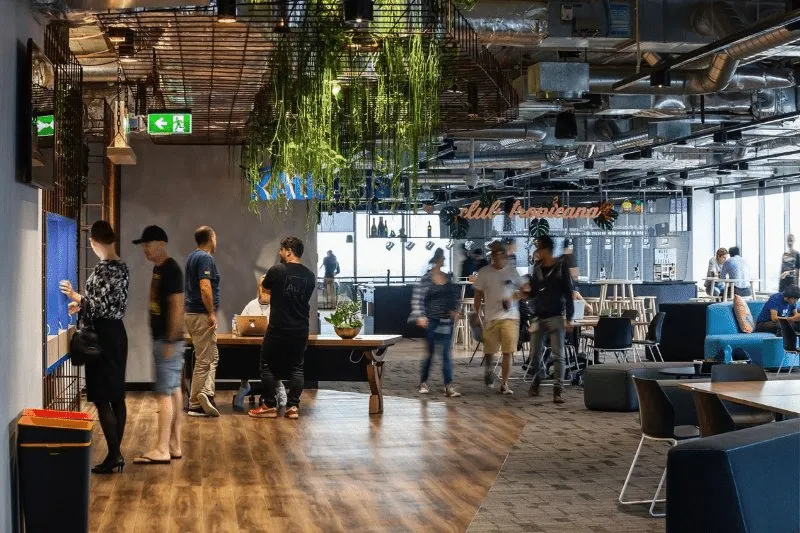
Atlassian Sydney office.
To find out how a global enterprise tackles the challenge, we spoke with three members of the Atlassian Design team:
- Ashleigh Sterzenbach – Senior Product Designer
- Erin Howard – Senior User Researcher
- Alastair Simpson – Head of Design, Confluence, Hipchat, and Platform
They revealed how the 2,200+ employee company structures its design team and process for collaboration, efficiency, and product quality.
Team Structure
Starting with just 6 designers in 2012, Atlassian’s design team has since grown to almost 200 employees, including designers, writers, and user researchers. The team is lead by Jürgen Spangl, the current Head of Design, who reports directly to the CEO.
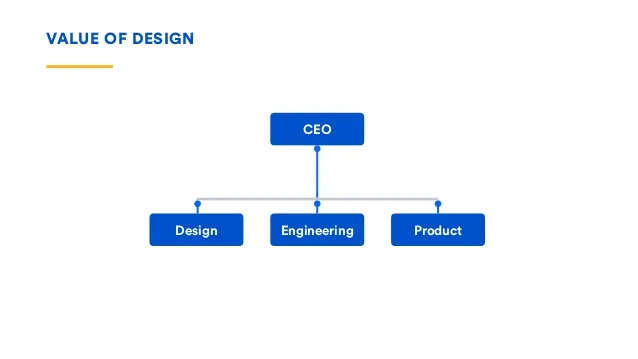
The design organization covers five disciplines:
- Information experience – Crafting the product content, interface copy, technical documentation
- User research – Researching and validating user needs
- Product design – Product improvements and new product development
- Creative team – Creating interactive marketing projects
- Design operations – Putting in place the right tools, processes, and vision to make design teams successful
Within the design operations group, the design systems team consistently pushes the boundaries by working with all product teams to implement the latest design language. Meanwhile, the information experience, user research, and product design teams fully embed into product teams.
To govern product development, Atlassian uses the triad model in which engineering, product management, and design all collaborate in making decisions.
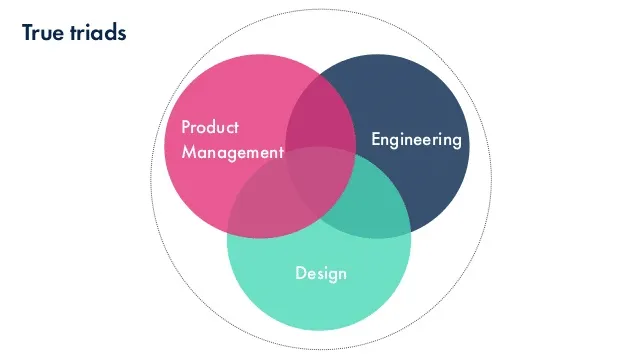
“You need healthy tension in the triad for solving engineering, business, and customer problems,” says Alastair. “If product performance suffers because of technical debt, it doesn’t matter how polished the features might feel. The triad is ultimately responsible for the whole experience.”
Based on the yearly strategy for the company and its product schedule, managers guide their teams in the right direction instead of prescribing every step of the roadmap. Whilst managers influence the overall strategy, the product triads have full autonomy to make decisions – managers don’t need to sign off on everything all the time.
Once a project starts, regular critiques and check-ins let managers ensure the triad’s work matches the high-level strategy.
“Individual contributors are given a lot of flexibility to investigate use cases and problems instead of following a baked-in roadmap that defines everything,” adds Erin. “And that helps us avoid the historical problem in tech of shipping quickly to hit a deadline without checking if the right problem is being solved.”
Atlassian’s Agile Design Process
To balance product quality with speed of implementation, Atlassian practices a design process that’s both structured and highly fluid. Following an Agile methodology where incremental updates are shipped regularly, product teams rely on collaboration rather than a purely linear process.
1. Creating context and alignment
The process always starts with reviewing data and research to identify knowledge gaps.
If they’re working on improving current features, for example, they may start with qualitative and quantitative data around product usage, use cases, and user activity. New product or feature development, however, requires more qualitative insights from generative research.
The team may spend up to a few weeks validating quick prototypes and running user research to make sure they’re honing in on the right problem statement:
- Who has the problem, and have we validated the problem exists?
- What is the problem? What data or research supports our assumptions?
- Why is the problem worth solving? What is the customer and business impact?
- Where does this problem occur?
Team members are encouraged to identify areas of risk and even pause the process to investigate further.
“As a user researcher, I’m hardwired to bring skepticism into the process,” says Erin. “For example, we once stopped the momentum of a product update because user comprehension wasn’t where it needed to be. We ended up running some more research studies and were able to solve the issue and deliver the right thing in the end.”
To create a complete picture of the customer journey, the triads will also conduct multiple explorative workshops and activities (described in more detail in Atlassian’s Team Playbook):
- Competitor analysis
- Writing a press release for the idea (like Amazon’s work-backwards tactic)
- User interviews, contextual inquiry, surveys, and other ethnographic research
- Baselining experiences
- Project canvas
- Experience canvas
- Job stories
- Persona cards and role cards
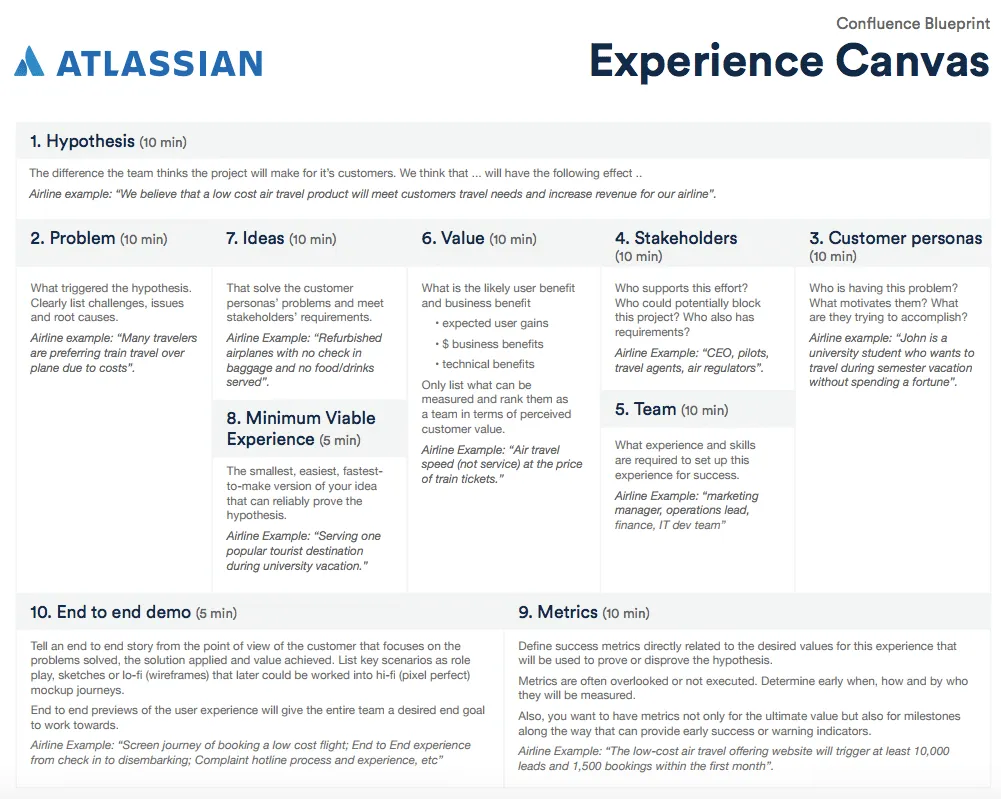
“You don’t want to jump into solutions too early in the process,” Alastair says. “Shipping doesn’t equal success — moving metrics for customers and your business does.”
2. Collaborating on ideation and creation
To deliver customer value as quickly as possible, product managers will help developers and designers break down large problem statements into smaller chunks of work. Members of the triad will then pair up to tackle each chunk of work.
“Engineers may not push pixels, but they’re absolutely involved in creating ideas,” Ashleigh says. “We pair up designers and developers as part of the process.”
When concepting, it’s quite common for designers like Ashleigh to run in-depth sketching sessions where designers, product managers, and developers all participate. In fact, the team rarely goes 24 hours without gathering feedback – whether it’s for a sketch, a wireframe, or a hi-fidelity prototype.
Product teams alternate between heads-down time and collaborative sessions with a strong regimen of activities:
- Standups (daily) – The triad reviews a “highlight reel” of updates, challenges, and to-do items for their projects.
- Team sparring (weekly) – A designer will explain the context and reasoning behind the designs, then ask peers in the triad for feedback. Each person marks up feedback individually, then the group debates the feedback. The designer then explains what feedback will be incorporated in the next version, and what won’t.
- Design detention (biweekly) – Designers across all product teams gather together (3 hours to the full day) to tackle challenges individually or in pairs, with sparring sessions happening afterwards. Email, chat, and meetings are all put on hold.
- Design blitzes (monthly) – Like a compressed design sprint, the triad collaborates across several hours on a complex challenge.
“There’s never just a ‘design-only’ phase,” Alastair says. “Sure, designers might be creating mockups on their own at some point, but everyone is involved in solving customer problems. You don’t build good products in isolation.”
3. Measuring the impact
Throughout the product development process, the triads regularly measure their work against the baseline metrics defined in the beginning.
Using tools like Attrakdiff, Treejack, and UserTesting, Atlassian summarizes the results of its user research and usability testing in a Non-Instrumented UX Scorecard with data like:
- Time on task
- Ease of use
- Success rate/ task completion
- Expectation measures
- Happy path clicks
- BERT (to measure emotional response).
“We always baseline and measure against what’s in the product today to ensure the new experiences are heading in a positive direction,” Ashleigh says. “This helps us build confidence in our design decisions as we move through the design process and continue to iterate.”
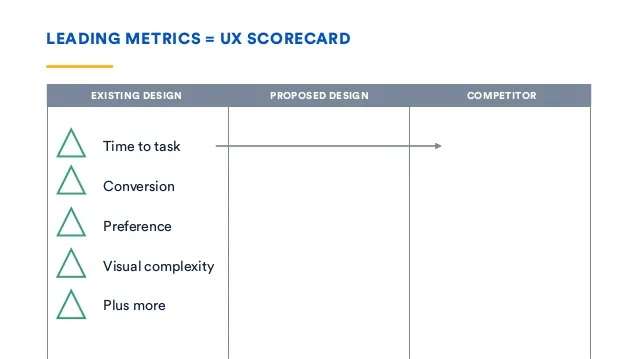
Atlassian’s UX Scorecard.
4. Shipping carefully and measuring regularly
Atlassian’s policy on shipping is best described as “measure twice, cut once.”
“We don’t work off an agency model,” says Alastair. “Designers are involved all the way through shipping.”
In fact, more technical designers can even participate in code reviews. The cycle of iteration, QA, and measurement allows triads to push both front-end and back-end updates to its cloud products every day.
After a product or feature launches, the triad tracks metrics in a Instrumented UX Scorecard. Now the team can check the real impact of the new experience by measuring the progression of customer behavior metrics.
“Millions of people on teams around the world depend on our tools to get work done,” says Alastair. “We must be purposeful and thoughtful with how we release changes.”
Conclusion
As Atlassian’s process shows, sometimes the key to a scalable process is in executing the fundamentals well.
Give design a seat at the executive table, structure product teams for natural collaboration, then give them room to make decisions every day. Replace bureaucracy with guidance and the self-governance model can actually succeed at scale.
“No team wants to be micromanaged. Every team wants ownership and accountability over what they’re building.” says Alastair. “Managers can’t oversee all the details — you hire smart people, ask the right questions, then get out of the way.”
Interested in being a designer at Atlassian? To see available positions, check out Atlassian Design Careers.


